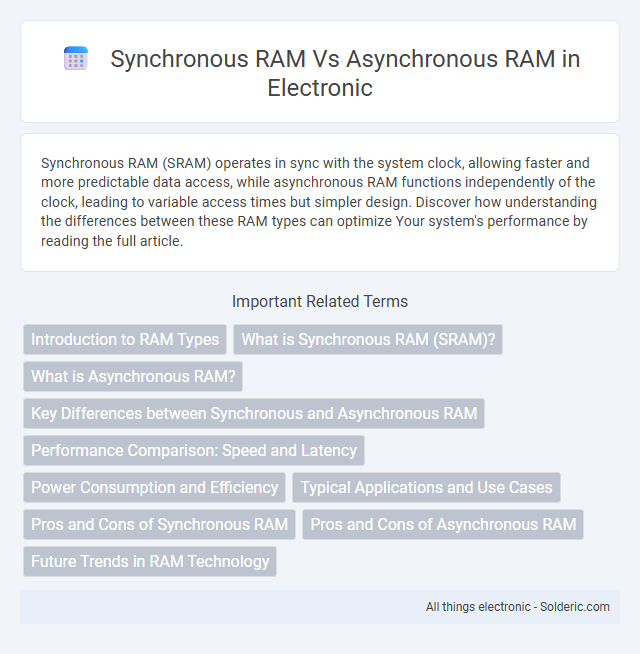Synchronous RAM (SRAM) operates in sync with the system clock, allowing faster and more predictable data access, while asynchronous RAM functions independently of the clock, leading to variable access times but simpler design. Discover how understanding the differences between these RAM types can optimize Your system's performance by reading the full article.
Comparison Table
| Feature | Synchronous RAM (SRAM) | Asynchronous RAM |
|---|---|---|
| Operation Timing | Operates in sync with clock signal | Operates independently of clock |
| Speed | Faster due to clock synchronization | Slower, delays vary with access |
| Use Case | High-speed applications like cache memory | General memory use, simpler design |
| Complexity | More complex control logic | Simpler control circuits |
| Power Consumption | Typically higher power due to clocking | Lower power, no clock needed |
| Data Access | Predictable timing, easy to pipeline | Variable timing, timing must be managed |
| Example | SDRAM, DDR RAM | FPM RAM, EDO RAM |
Introduction to RAM Types
Synchronous RAM (SRAM) operates in sync with the system clock, offering faster data access and improved performance for tasks requiring rapid memory retrieval. Asynchronous RAM (Async RAM) functions independently of the system clock, resulting in variable access times suited for simpler or slower applications. Understanding these differences helps you choose the right RAM type based on speed requirements and system compatibility.
What is Synchronous RAM (SRAM)?
Synchronous RAM (SRAM) is a type of volatile memory that synchronizes its operations with the system clock, allowing faster and more predictable access times compared to asynchronous RAM. It stores data using flip-flops, providing high-speed performance suitable for cache memory in CPUs and other applications requiring rapid data access. Your system benefits from SRAM's consistent timing and reduced latency, improving overall processing efficiency.
What is Asynchronous RAM?
Asynchronous RAM is a type of random access memory that operates independently of the system clock, allowing data to be read or written at any time without synchronization delays. This memory is typically slower than synchronous RAM because it relies on control signals rather than clock signals for timing, leading to variable access times. Asynchronous RAM is commonly used in simpler or older systems where precise timing coordination with the CPU is not critical.
Key Differences between Synchronous and Asynchronous RAM
Synchronous RAM operates in sync with the system clock, enabling faster and more predictable data transfer rates, while Asynchronous RAM functions independently without a clock signal, resulting in variable access times. Synchronous RAM is commonly used in modern computing applications requiring high-speed performance, whereas Asynchronous RAM is typically found in simpler, lower-speed devices. The synchronization of Synchronous RAM allows for easier integration with CPUs and better timing control, contrasting with the flexible but slower response time of Asynchronous RAM.
Performance Comparison: Speed and Latency
Synchronous RAM (SRAM) offers faster data access speeds due to its alignment with the system clock, enabling predictable timing and lower latency compared to Asynchronous RAM (DRAM), which operates independently of the clock and experiences variable latency. SRAM's design allows it to deliver rapid read/write cycles crucial for high-performance computing tasks, while Asynchronous RAM, though typically slower, can be advantageous in cost-sensitive applications where speed is less critical. Understanding these differences helps you choose the memory type that balances performance needs with budget constraints.
Power Consumption and Efficiency
Synchronous RAM (SRAM) consumes more power than Asynchronous RAM due to its continuous clock signal operation, making it less energy-efficient in low-demand scenarios. Asynchronous RAM activates only during data access, resulting in lower power consumption and higher efficiency for applications with sporadic memory use. Your choice between the two should consider the balance between performance needs and power efficiency requirements.
Typical Applications and Use Cases
Synchronous RAM (SRAM) is ideal for high-speed applications like CPU cache memory, where rapid access and synchronization with the system clock improve overall performance in computing devices. Asynchronous RAM, commonly used in simpler systems like microcontrollers and basic embedded devices, operates without a clock signal and fits applications requiring flexible and slower memory access. Your choice depends on whether you need faster, clocked memory interaction (SRAM) or cost-effective, low-speed storage (asynchronous RAM) for your system.
Pros and Cons of Synchronous RAM
Synchronous RAM (SRAM) offers faster data access speeds by synchronizing with the system clock, which improves overall performance in applications requiring rapid data retrieval. However, its complexity and higher power consumption compared to asynchronous RAM make it less efficient for low-power or cost-sensitive devices. Your choice of SRAM should consider the balance between speed benefits and increased energy use depending on your system's requirements.
Pros and Cons of Asynchronous RAM
Asynchronous RAM offers simplicity and cost-effectiveness by operating independently from the system clock, allowing flexible timing for data access which can be advantageous in certain low-speed or mixed-timing applications. However, its drawbacks include slower access times compared to Synchronous RAM and increased complexity in maintaining data integrity since it lacks synchronization with the CPU clock, which can lead to timing issues in high-performance systems. If your application prioritizes speed and coordination with the CPU, Asynchronous RAM may not meet your performance requirements despite its lower cost.
Future Trends in RAM Technology
Future trends in RAM technology emphasize the development of Synchronous RAM (SRAM) with higher clock speeds and improved timing accuracy to support advanced computing needs such as artificial intelligence and real-time data processing. Asynchronous RAM (ARAM) continues to evolve for low-power applications, benefiting from innovations in energy-efficient memory architectures and integrated circuit design. Emerging hybrid memory solutions aim to combine the speed of SRAM and the flexibility of ARAM, enabling scalable performance for next-generation devices and systems.
Synchronous RAM vs Asynchronous RAM Infographic

 solderic.com
solderic.com